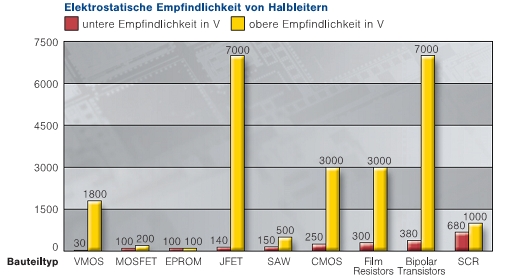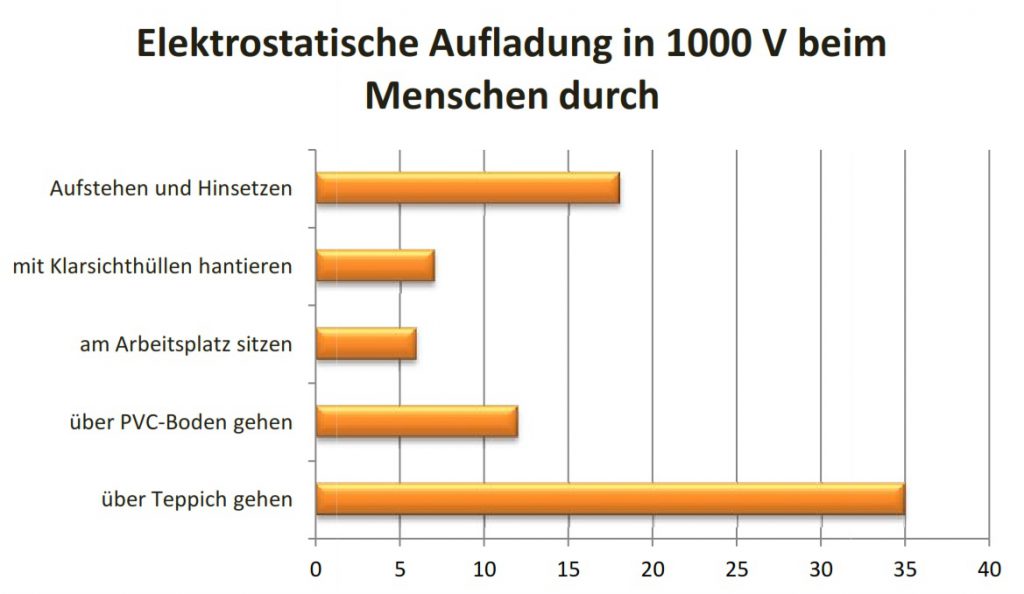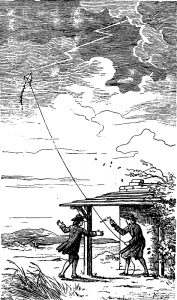Term
The Problem
Development
Minimization
History
Term
The term “ESD” is the abbreviation for “ElectroStatic Discharge” and refers to the moment of the potential equalization between two different electrostatically charged bodies.
Depending on the amount of charge difference and nature of the bodies, people may perceive this discharge or not. People may perceive the discharge in the form of a lightning storm, whereas a discharge at chip level is invisible to our senses.
The Problem
Electronics make our lives easier.

Technology controls mobility, facilitates communication and saves lives. The use of electronics is obvious and ubiquitous today. Navigation systems and ABS increase safety and comfort while driving. State of the art electronics ensure smooth operations in the aviation sector. Dozens of computers form the brain of the aircraft on board.
Today, electronic components are designed based of the requirements of energy saving, miniaturization and high speed for operating at low voltages. As an example, modern USB devices operate with a voltage of 5V. Blue LEDs from Indium Gallium Nitride (InGaN) according to manufacturer data sheets are in danger of damage at an electrostatic discharge of 50 V.
Usually, the ESD sensitivity decreases the more a device is integrated. This means that the component alone is very sensitive. The printed circuit board should be able to handle a higher load. If a device is intended for use by consumers and appropriately sealed, it should be able to be safely handled as intended.
If components, however, are faced with voltages that lie outside of their range, there is an acute danger of damage or destruction. Depending on the error pattern, one speaks of damage caused by ESD or EOS. There is no exact line between the two. Often, damage caused by EOS follows a previous ESD event. Ironically, the destruction is here a positive result, since it can be proved by measurement. More frequent and more dangerous is latent damage, where a component is only degraded and not destroyed.
Each damaged component incurs costs, and the later an error is discovered, the more expensive it is to correct it. If product failures affect customers, the costs soar and, in the worst case, lives may be at risk!
Development
Since electrostatic charges are generated mainly by friction, contact and separation, human beings represent the greatest risk potential for highly sensitive electronic devices.

Electrostatic charges that result from the movements of people generate voltages of up to several thousand volts.
Within a workspace, we usually have to deal with different materials. Depending on the position in the triboelectric series, tremendous loads can also occur when these materials are moved against each other.
As an example, friction from stretch film on a plastic container in the summer cargoes can produce over 10,000 V. Especially the removal of “normal” tapes can lead to enormous charges. The increased adhesion by the adhesive properties of the tape increases the probability that high charges are generated.
Charged plastic parts can hold static charges for very long. Any electrostatic charge has a field which may cause potential shifts in other materials. This variant is called induction charging. As long as the inducted field is present, additional ESD events may be caused.
Minimization
History
Minimization
Due to the physical laws to which we are all subject, the risk of electrostatic charging can never be avoided completely. There is only a controlled reduction of the effects in order to reduce the consequences as far as possible.
In the electronics industry, the establishment of an ESD control programme plan is always required, according to IEC 61340-5-1. This ensures a uniform electrostatic potential during continuous monitoring and thus avoids the risk of electrostatic discharge.
We will gladly assist you in setting up your own ESD control plan, which is essentially based on the following principles:
– Avoid insulating plastics in the work environment.
– Ground all conductive and static dissipative products.
– Regularly check the implemented protection products.
– Train all employees.
– Commit your customers and suppliers to comply with the ESD protection.
History
The history of electrostatics or dormant electric charges has many interesting anecdotes.

Not by chance is the term derived “electricity” from the Greek word “electron” meaning “amber”. Starting from the first documented attempt in ancient times by Thales of Miletus using animal skins, there were other high points of interest in the 13th century with Petrus Peregrinus and in the 18th Century with, among others, Benjamin Franklin, that not only justify our current understanding, but that also make our daily life more comfortable.
The names of the entities with which we describe the various forces and phenomena today are derived from the names of the scholars, who achieved important breakthroughs with some seemingly absurd ideas.
Some examples:
– Experiments with shipbuilding means at the end of the 18th Century Charles Augustin de Coulomb helped in the development of the law named after him.

– Georg Simon Ohm, who rose from being the son of a locksmith from Erlangen to the Professor of Experimental Physics in Munich.
– the 3.65 m wooden cube with copper wire stringing by the bookbinder’s son Michael Faraday, the results of which we benefit from every time we drive in a storm.
Although the principles were described a long time ago, the resulting opportunities are virtually unlimited. The ongoing miniaturisation and acceleration of everyday technology today allows us to measure values in the range of a few Angstrom to visualise and use and effects with speeds in the attosecond domain.
We take a curious look at current research and the resulting developments and share interesting developments in the ESD world with you.
